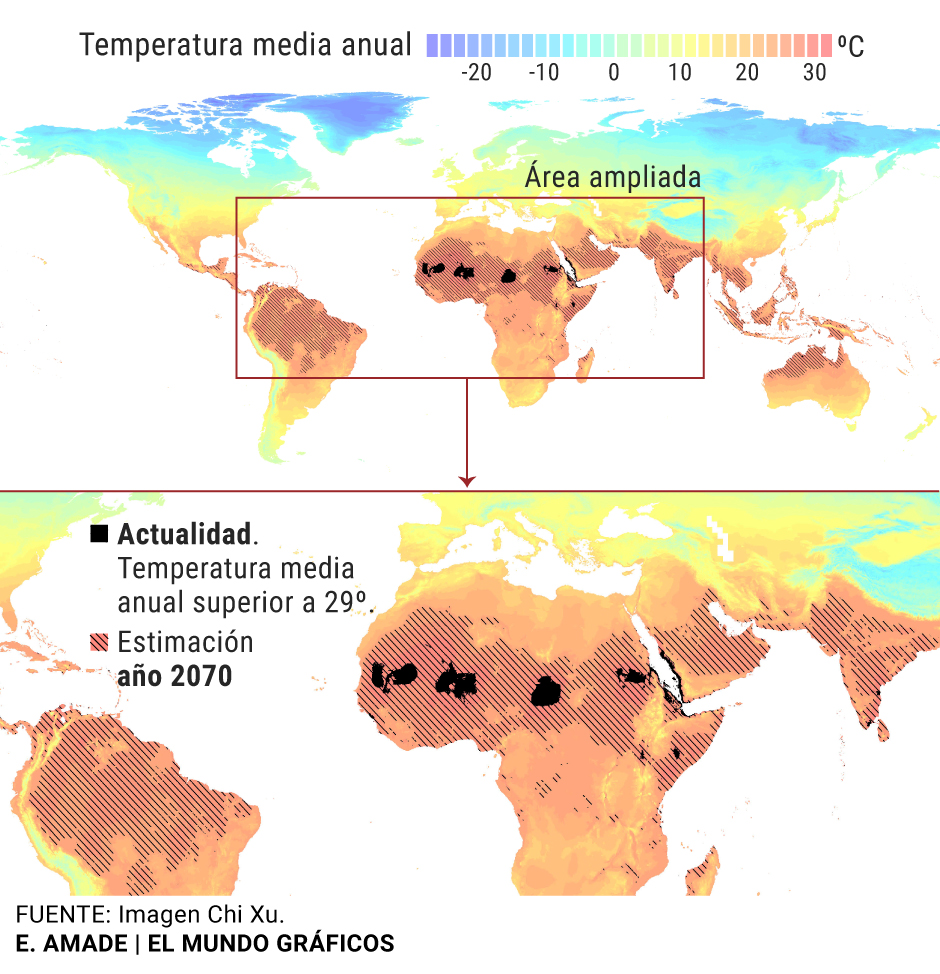- New decade: the 10 challenges of humanity to solve the climate crisis
- Climate: The era of ecological awareness: how we learned that there is only one Earth
- Draft. The Government presents the new Climate Change Adaptation Plan
50 years from now, a third of the world's population could live in areas as hot as the hottest spots in the Sahara are today if greenhouse gas emissions continue to rise. It is one of the main conclusions of an investigation that has analyzed the evolution of the so-called "climatic niches" in which human societies have thrived for 6,000 years.
The work, published this Monday in the journal Proceedings of the National Academy of Sciences ( PNAS ), indicates that between one and 3.5 billion people worldwide could be forced to migrate as the average annual temperature of the regions increases in those that live and become practically uninhabitable areas, as they would not only pose a threat to their health but also to food production
Currently, areas with an annual average temperature above 29 degrees Celsius are mainly limited to certain regions of the Sahara (indicated on the map with small dark brown spots) that occupy just under 1% of the Earth's surface. The scientists who sign this international study believe that these extremely hot areas will expand in a scenario of very high greenhouse gas emissions (called RCP 8.5 in United Nations climate documents) until they reach 19% of the surface of our planet.
According to this estimate, India would be the most affected country, as more than 1,200 million people would move to live in areas of extreme heat. In Nigeria, 485 million citizens could be affected, while in Pakistan there would be 100 million living in these conditions, a figure similar to that of Indonesia and Sudan.
Regarding America, the study estimates that in Brazil there will be 27.3 million people affected; in Colombia, 24.2 million; in Venezuela, 22 million; in Mexico, 14.8 million and in Guatemala about 9 million people. Nowhere in Spain would such a high average temperature be reached.
Currently, there are about 7.8 billion inhabitants on Earth and according to the United Nations, this figure is expected to increase by 2 billion in 2050, to 9.7 billion. At the end of the century it could reach 11,000 million inhabitants. Africa is the fastest growing continent.
Evolution over 6,000 years
To carry out this study, the team led by Marten Scheffer, from the University of Wageningen (Netherlands), analyzed data from various sources including global temperatures, records of human populations and estimates of land uses from the Holocene -6,000 years ago years - until 2015. They also made estimates of the climatic conditions and population that will be in 2070.
The researchers note that the majority of human populations and crops are currently concentrated in regions whose average annual temperatures tend to be between 11 and 15 degrees Celsius while a lower number reside in areas where the average temperature is around 20-25ºC. Those conditions conducive to human settlement and the flourishing of crops have been fairly stable since the mid-Holocene despite technological improvements.
However, if emissions are not significantly reduced, they believe that by 2070 a third of the world's population will live in areas with climatic conditions hostile to food production. Xu Chi, a researcher at Nanjing University in China and co-author of the study, admits they were amazed by his initial results, so they spent an additional year checking their calculations.
Marten Scheffer sees a parallel between the results of his study and the current pandemic and considers that in the same way that the coronavirus has transformed the world in a way that is difficult to imagine a few months ago, with the climate crisis something similar could happen: "The This change would take place less quickly, but unlike the pandemic, there would be no improvement to wait: large areas of the planet would heat up and never cool down again, which would not only have devastating direct effects, but would also reduce the capacities of societies. to face future crises, "reflects Scheffer, who believes that the only way to reverse that trend is to cut emissions quickly.
According to the criteria of The Trust Project
Know more- Science and health
- science
- Climate change
- Environment
- Graphics
Climate crisis Melting ice in Greenland and Antarctica has increased sea level by 1.4 centimeters since 2003
Earth Day Europe heats up faster than the rest of the planet
EnvironmentThe Government presents its roadmap for Spain to survive the climate crisis

